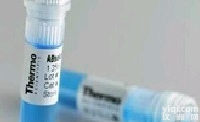本公司提供科研
Frataxin线粒体型共济失调蛋白抗体,抗体质量可靠,订购
Frataxin线粒体型共济失调蛋白抗体请联系在线客服或者销售人员。
抗体参数如下>>>>
中文名称:
线粒体型共济失调蛋白抗体英文名称:
Anti-Frataxin货号:bs-9601R
抗体来源:兔
克隆类型:多克隆
蛋白分子量:predicted molecular weight: 19kDa
纯化方法:affinity purified by Protein A
交叉反应:hu, mo, rat, dog, pig, cow, hrs, chk
测试应用:ELISA=1:500-1000 IHC-P=1:100-500 IHC-F=1:100-500 IF=1:100-500
(石蜡切片需做抗原修复)
not yet tested in other applications.
optimal dilutions/concentrations should be determined by the end user.
产品背景介绍:Friedreich ataxia is a progressive neurodegenerative disorder caused by loss of function mutations in the frataxin gene. The human frataxin gene maps to chromosome 9q13.The frataxin gene encodes a mitochondrial protein of the same name. Frataxin assembles into a stable homopolymer with iron-binding capabilities. When expressed in E. Coli human frataxin binds iron atoms at a rate of 10 iron atoms per 1 molecule of the frataxin polymer. Thus, frataxin appears to function in some capacity for iron-storage for the mitochondria. Frataxin may also function as an activator of oxidative phosphorylation to increase mitochondrial membrane potential and elevate cellular ATP. Frataxin is expressed in tissues with high metabolic activity including heart, liver and brown fat.Function : Promotes the biosynthesis of heme and assembly and repair of iron-sulfur clusters by delivering Fe(2+) to proteins involved in these pathways. May play a role in the protection against iron-catalyzed oxidative stress through its ability to catalyze the oxidation of Fe(2+) to Fe(3+); the oligomeric form but not the monomeric form has in vitro ferroxidase activity. May be able to store large amounts of iron in the form of a ferrihydrite mineral by oligomerization; however, the physiological relevance is unsure as reports are conflicting and the function has only been shown using heterologous overexpression systems. Modulates the RNA-binding activity of ACO1.Subunit : Belongs to the frataxin family.Subcellular Location : Cytoplasm. Mitochondrion. PubMed:18725397 reports localization exclusively in mitochondria.Tissue Specificity : Expressed in the heart, peripheral blood lymphocytes and dermal fibroblasts.Post-translational modifications : Processed in two steps by mitochondrial processing peptidase (MPP). MPP first cleaves the precursor to intermediate form and subsequently converts the intermediate to yield frataxin mature form (frataxin(81-210)) which is the predominant form. The additional forms, frataxin(56-210) and frataxin(78-210), seem to be produced when the normal maturation process is impaired; their physiological relevance is unsure.DISEASE : Defects in FXN are the cause of Friedreich ataxia (FRDA) [MIM:229300]. FRDA is an autosomal recessive, progressive degenerative disease characterized by neurodegeneration and cardiomyopathy it is the most common inherited ataxia. The disorder is usually manifest before adolescence and is generally characterized by incoordination of limb movements, dysarthria, nystagmus, diminished or absent tendon reflexes, Babinski sign, impairment of position and vibratory senses, scoliosis, pes cavus, and hammer toe. In most patients, FRDA is due to GAA triplet repeat expansions in the first intron of the frataxin gene. But in some cases the disease is due to mutations in the coding region. [MISCELLANEOUS] The unusual migration profile of mature frataxin on SDS-PAGE due to its acidic N-terminus most likely contributed to conflicting reports for the N-terminus of the mature protein. Unlike prokaryotic and yeast frataxin homologs, which self-assemble at high iron concentrations, oligomerization of human frataxin is not induced by iron. The existence of a specialized mitochondrial ferritin in mammalia (FTMT) is suggesting that iron storage would be redundant function, at least in mammalian mitochondria.Similarity : Belongs to the frataxin family.
 Anti-Frataxin线粒体型共济失调蛋白抗体
Anti-Frataxin线粒体型共济失调蛋白抗体
 Anti-Frataxin,线粒体型共济失调蛋白抗体
Anti-Frataxin,线粒体型共济失调蛋白抗体
 Anti-Frataxin线粒体型共济失调蛋白抗体
Anti-Frataxin线粒体型共济失调蛋白抗体
 Anti-Frataxin抗体,线粒体型共济失调蛋白抗体说明书/价格
Anti-Frataxin抗体,线粒体型共济失调蛋白抗体说明书/价格
 Anti-Frataxin抗体 线粒体型共济失调蛋白抗体
Anti-Frataxin抗体 线粒体型共济失调蛋白抗体
 Anti-Frataxin抗体 线粒体型共济失调蛋白抗体
Anti-Frataxin抗体 线粒体型共济失调蛋白抗体
 Anti-Frataxin抗体,线粒体型共济失调蛋白抗体
Anti-Frataxin抗体,线粒体型共济失调蛋白抗体
 Frataxin抗体 线粒体型共济失调蛋白抗体
Frataxin抗体 线粒体型共济失调蛋白抗体
 胶体金标记的线粒体型共济失调蛋白抗体
胶体金标记的线粒体型共济失调蛋白抗体
 hy039601 线粒体型共济失调蛋白抗体,Anti-Frataxin
hy039601 线粒体型共济失调蛋白抗体,Anti-Frataxin
 线粒体型共济失调蛋白抗体
线粒体型共济失调蛋白抗体
 Frataxin线粒体型共济失调蛋白抗体
Frataxin线粒体型共济失调蛋白抗体